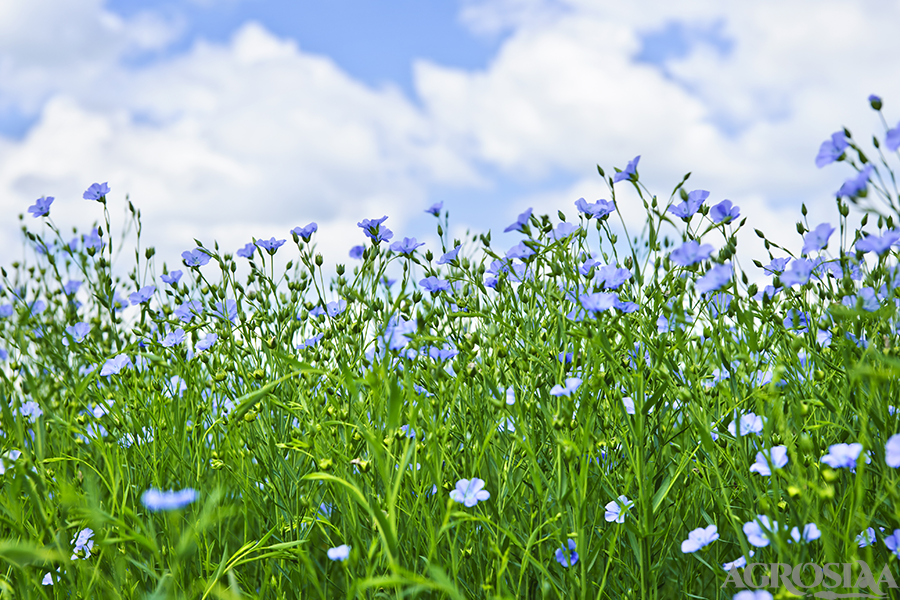Jawas or Alshi
Linaceae
Linum usitatissimum
Malshiras 10, Solapur -36, N-3, N-55, R-552, Kiran, Sheetal, Jawahar-23, No-4- 29, NP-11, Type No-1, type No 126, Mukta, hira and K-2
Linseed is rabi season crop.
It is temerate crop. It needs cold climate. Crop needs temperature 25- 30 0 c during germination and 15-20 0 c during seed formation. Linseed requires average rainfall about 450 to 750 mm.
It grows well on medium to deep cotton soil and alluvial loams, well drained. The crop can tolerate soil acidity to some extent but ideal pH is 6. o.
It needs a weed free and fine seed bed. After harvest of the previous crop one ploughing followed by two to three harrowings are given.
Thiram @ 3 g/kg of seed + Bavistin @ 2 g/kg of seed to control seed borne diseases.
Drilling and broad casting methods are used for sowing linseed crop.
First fortnight of October is proper time for sowing.
Distance between two row is 30 cm.
Distance between two plant is 15 cm.
Small seeded crops for oil purpose – for drilling = 8 to 10 kg/ha
Bold seeded crops for fiber purpose-for drilling= 20 to 25 kg/ha
Broadcasting= 40 kg/ha
Rainfed crop generally not required interculturing . When the crop is irrigated one weeding is required.
Rainfed = FYM / Compost 4- 5 tones/ha
Apply 25 : 25: 00 kg NPK at sowing time only
Irrigated = 8 to 10 tonnes of FYM or compost /ha
Apply 60 : 30 : 00 kg NPK /ha. 30 kg N and 30 kg P at the sowing time and
remaining 30 kg N after 40-45 days after sowing.
It is mainly grown as rainfed crop on store soil moisture. If irrigation facilities are available one or two light irrigation may be given at 30-35 and 50-55 days after sowing.
When the crop is irrigated one weeding is required . Rainfed crop is not required interculturing.
Important pest of linseed crop is gall fly which damage the flower buds. It can be controlled by spraying of Phosphomidon or dimethioate. Termites and cutworms can be controlled by soil application of Aldrin 5% at last harrowing.
Linseed crop is usually grown in rotation with hybrid sorghum , Maize, pearl millet, Groundnut, Cow pea and Soybean. It is also sown as mixed crop with wheat , barley, gram and mustard Intercrop Linseed + gram (4: 2 row proportion),Linseed + safflower (4 : 2 )
Retting and Extraction of Fiber from linseed
Retting is a process of treatment of stalk for final fiber extraction. When the fiber is
desired along with seed the harvesting should be done at physiological maturity when
crop is still green. Immediately after harvesting the plants tie in bundles and cut small
upper portion of plants with seed ball. Then stalks bundles are steeped in running /
flowing water in river/ stream just enough to cover the material. The stalks bundles
also steeped in stagnant water . Retting in stagnant water is faster than running /
flowing water. Generally it takwes 4-6 days for proper retting. After removing the
retted straw from water it should be cleaned in running water and then dried. The
extraction of fire requires simple machine. The machine in indigenouly designed on
the principle of passing the straw through fluted rollers to break the woody cores and
separate the fibres. Linseed polants are not fed to cattle linseed plants contains a cyanogenic glucoside linamarin which by the action of an enzyme (glucosyl transfer) forms prussic acid which is toxic to animals.
The crop matures in 100 days from the sowing. The crop may be harvested when
the leaves are dry, plant turn golden yellow in colour the seed ball (capsules)
become dry and bownish in colour, seed have become shiny.
Harvesting is done cutting the plants close to the ground with the help of sharp sickle or uprooting the plants. Then tie in bundles and stacked in the threshing yard for drying. Threshing is done under the feet of bullocks or by beating with sticks.
Average of yield of rainfed linseed = 3-5 Qtls /ha
Average yield of irrigated linseed = 8-10 Qtls /ha
Fire yield= 4-6 Qtls/ha
stored in bins , gunny bags, Polythene bags
Oil Industry, Fiber , Paint factory etc.
1) It is an important oilseed and fiber crop.
2) Due to its quick drying property it is used for the preperation of paints , varnishes , Printing ink, Oil cloth, Soap, Patent leather and water proof fabrics.
3) Husk and straw is a good raw material used for making tissue paper fire fighting hose pipes and rugs.
4) Oil cake is a very good cattle feed. Oil cake contains 35% protein.
5) It is also used as organic manure. It contains abot 5% N, 1.4 % P and 1.8 %K.
6) In western countries is mainly grown for fiber purpose for manufacturing of the linen goods.
7) Seed contains oil varies from 35-42% and flax (fiber) contains 80-90 % cellulose.
Grading cleaning and packing in 30 kg or 10 kg bags or storage bins.
Maharashtra, Madhya Pradesh, Uttarpradesh. In Maharashtra :- Marathwada and Western Maharashtra










